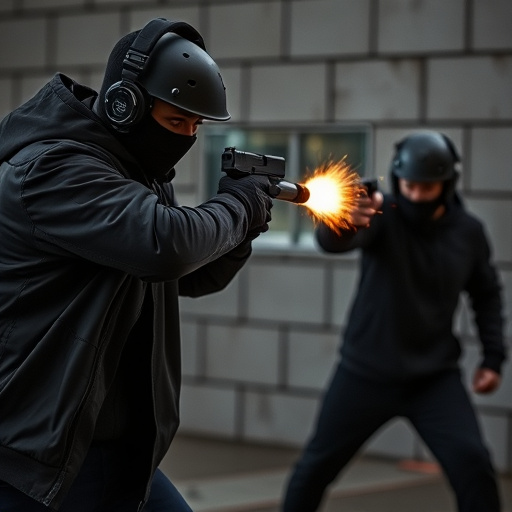Tasers and stun guns, both non-lethal self-defense tools, differ in their incapacitation methods: Tasers use probes to disrupt nerve signals, while stun guns generate high-voltage pulses that override motor functions. Modern tasers often include safety features like disable pins for user control, whereas stun guns typically lack them. The market offers innovative options, such as a pink stun gun with a disable pin safety feature, highlighting advancements in personal protection tools. This compact, aesthetically pleasing device combines advanced safety mechanisms and powerful shocks, providing users with reliable and secure self-defense.
“Uncover the distinct world of personal defense tools with our comprehensive guide on Tasers and Stun Guns. From their historical evolution to modern innovations like the Pink Stun Gun, we explore these devices’ unique features. Learn how Tasers use electrical pulses to disrupt muscle control, contrasting with traditional stun guns that deliver a powerful electric shock. Discover key differences, safety considerations, including disable pin mechanisms, and why the Pink Stun Gun stands out as a versatile option for self-defense enthusiasts.”
- Understanding Tasers and Stun Guns: An Overview
- The Evolution of Personal Defense Devices
- Unique Features of the Pink Stun Gun
- How Tasers Work: A Detailed Explanation
- Stun Guns vs Tasers: Key Differences
- Safety Considerations: Pin Mechanisms and More
Understanding Tasers and Stun Guns: An Overview

Tasers and stun guns are both non-lethal weapons designed to incapacitate individuals, but they operate on distinct principles. Tasers, formally known as Conductivity Energy Devices (CEDs), use electrical current to disrupt muscle control, causing the target to fall to the ground temporarily. They fire two small probes connected to wires that deliver a powerful electric shock. In contrast, stun guns generate high-voltage, low-current electrical pulses that override the body’s motor functions, resulting in a brief loss of balance and strength.
While both tools share similar goals, specific features set them apart. For instance, modern tasers often include safety mechanisms like disable pins to prevent accidental discharge, while stun guns typically lack such advanced trigger protections. Additionally, taser probes are designed for short-range deployment, whereas stun guns can deliver a shock from a farther distance. When considering self-defense options, understanding these differences is crucial, especially with modern variations like the pink stun gun with a disable pin safety feature on the market.
The Evolution of Personal Defense Devices

Personal defense devices have evolved significantly over time, reflecting societal changes and technological advancements. Historically, tools like knives and batons dominated the self-defense landscape, but the 21st century has seen the emergence of more advanced options, such as tasers and stun guns. These modern defenses offer users a non-lethal way to protect themselves against potential threats, with stun guns gaining particular popularity due to their compact size and ease of use.
One notable trend in this category is the development of innovative designs like the pink stun gun with disable pin safety feature. This type of stun gun not only adds a layer of aesthetic appeal but also incorporates advanced safety mechanisms. The disable pin ensures that the device cannot be accidentally activated, providing users with an extra level of control and peace of mind when carrying it for personal protection.
Unique Features of the Pink Stun Gun

The Pink Stun Gun stands out among its counterparts not just for its eye-catching color but also for its unique features designed with safety and effectiveness in mind. One of its standout aspects is the integrated disable pin safety feature. This mechanism ensures that the stun gun cannot be fired accidentally, providing an extra layer of protection during use. The disable pin must be intentionally released by the user, preventing unauthorized deployment and minimizing the risk of unintended discharges.
Moreover, the Pink Stun Gun’s ergonomic design and compact size make it easy to carry and operate. This portability allows users to maintain a sense of security and preparedness without compromising mobility or comfort. In terms of functionality, the stun gun delivers a powerful electric shock that can temporarily disable an attacker, providing ample time for escape or assistance. Its unique features, combined with its striking color, make it an attractive option for individuals seeking both style and protection.
How Tasers Work: A Detailed Explanation

Tasers, officially known as Conductivity Energy Devices (CEDs), operate by delivering a controlled electric shock to disrupt an individual’s muscular control, temporarily incapacitating them. When activated, a Taser fires two thin, conductive probes connected to high-voltage, low-current electrical circuitry. This electricity overloads the body’s natural protective response, causing muscles to contract uncontrollably and leading to loss of balance and coordination.
Unlike traditional stun guns that deliver a single, concentrated shock, Tasers use a network of small electrodes on the probes to distribute the electric current across a larger area, making them effective at distances up to 35 feet. Additionally, modern Tasers like the pink stun gun with a disable pin safety feature offer enhanced user safety by requiring a deliberate action (inserting and pulling the disable pin) before each shot, minimizing accidental discharges.
Stun Guns vs Tasers: Key Differences

Stun guns and tasers are both non-lethal weapons designed to incapacitate an attacker, but they operate on distinct principles. The primary difference lies in their mechanism of action. Stun guns emit a high-voltage electric discharge that disrupts muscle control, causing the target to experience intense pain and temporary paralysis. This makes them effective for self-defense against close-range assailants. In contrast, tasers use two thin probes connected to cables to deliver an electrical current, which disrupts nerve signals and causes muscle spasms. Tasers are known for their longer range and the ability to target multiple attackers simultaneously, making them popular among law enforcement agencies.
When comparing stun guns vs tasers, features like range, power, and safety mechanisms differ significantly. For instance, a pink stun gun with a disable pin safety feature combines aesthetic appeal with enhanced security. This type of stun gun is designed to be easily recognizable as non-lethal, potentially deterring attackers and ensuring user safety. Such weapons are popular choices for individuals seeking personal protection without the need for lethal force.
Safety Considerations: Pin Mechanisms and More

When comparing tasers and stun guns, one key area to consider is safety—especially when it comes to devices designed for personal protection. A notable difference lies in their pin mechanisms. Many modern stun guns feature a disable pin safety feature, where a user must physically insert or remove a pin to activate the device. This simple mechanism acts as a crucial barrier, ensuring accidental activation doesn’t occur and providing users with more control over when the stun gun is set into a ready state.
In contrast, tasers generally don’t incorporate such pins. Instead, they use electrical impulses to disable a target. While this technology is effective, it also raises safety concerns, as improper or unexpected use could lead to adverse effects on bystanders or even the user themselves. The absence of a physical pin mechanism in tasers underscores the importance of proper training and understanding of their operation to mitigate potential risks.
In conclusion, both tasers and stun guns serve as valuable personal defense tools, each with unique characteristics. While tasers deliver a powerful electrical shock that temporarily disables an assailant, stun guns focus on inducing muscle spasms through high voltage pulses. The Pink Stun Gun stands out with its compact design and built-in disable pin safety feature, making it a convenient option for those seeking immediate protection. Understanding the key differences and safety considerations, such as the importance of proper training and pin mechanism functionality, is crucial when choosing between these devices to ensure their effectiveness in stressful situations.
